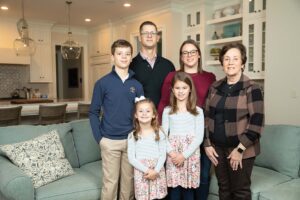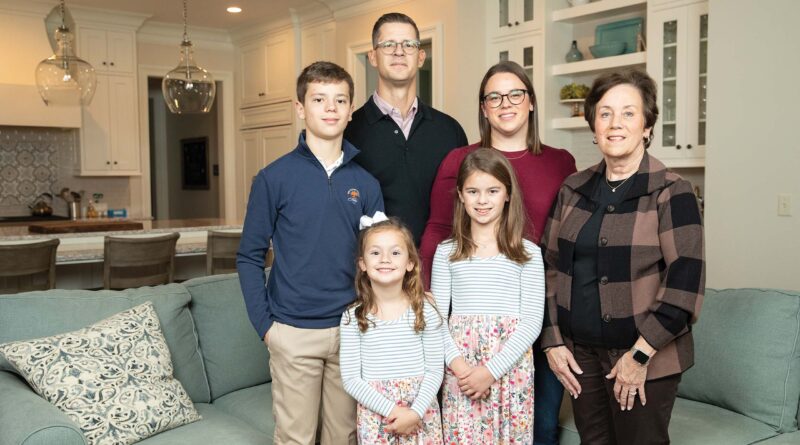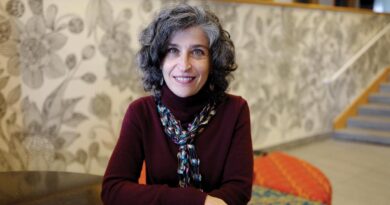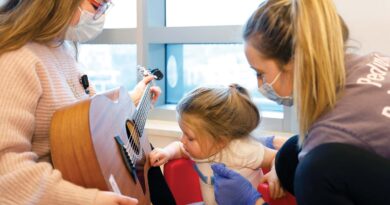Families Supporting Families
Published on January 24th, 2024 by Diana Duren.
No parent ever expects a doctor to say, “your child has cancer” or “your child needs multiple surgeries to fix prematurely fused bones.” Monroe Carell Jr. Children’s Hospital at Vanderbilt care teams meet families during some of the hardest moments in their lives. Doctors, nurses and staff commit to provide hope and healing to countless families. And in turn, many of those families feel passionate about paying it forward to help other children. We share two such stories here.
Daughter’s cancer journey inspires Morrison family to give back

When Lindsay and Erik Morrison’s daughter, Caroline, was diagnosed with cancer at age 2, they found strength and faith in family and the community.
They also found inspiration to turn their daughter’s cancer diagnosis and journey into a meaningful way to help other children and families at Monroe Carell Jr. Children’s Hospital at Vanderbilt.
Within weeks of Caroline’s diagnosis of neuroblastoma, a cancer that originates in the nerve tissue cells and primarily affects children younger than 5, the Morrisons began the process to establish the Caroline Morrison Pediatric Oncology Research Fund.
“There was obviously a flood of emotions after Caroline’s diagnosis,” Erik said. “You think about your family and how you can take care of your family, but I also know we’ve been very fortunate and have resources that many others don’t have. I thought immediately, ‘What can we do to try to improve the circumstances for others that are facing a similar situation?’”
In 2019, Lindsay didn’t think anything was seriously wrong with her youngest child, Caroline, when she brought the toddler to the pediatrician. Caroline had trouble with balance, but the couple thought it could be related to antihistamine medication.
The pediatrician saw how she struggled to stand from sitting position on the floor, prompting concerns that Caroline might have a form of muscular dystrophy. A referral to a Monroe Carell pediatric neurologist ruled out muscular dystrophy, but he discovered that Caroline had no sensation or reflexes in her legs, knees and feet. He wanted an MRI to look for any possible neurologic disorders affecting her spine.
“They found a 4-inch tumor on her spine. You know something’s wrong, but you don’t know what’s wrong, and you don’t think it’s cancer. You don’t ever think it’s cancer, right? Especially for a 2-year-old,” Lindsay said. “At first, there was this panic, and my first thought was, ‘I don’t want my baby to die.’”
As they met with Caroline’s team of Monroe Carell doctors — Dan Benedetti, MD, MA (pediatric oncology); Chris Bonfield, MD, (pediatric neurosurgery); and Bo Lovvorn, MD, (pediatric surgery) — they learned more about the neuroblastoma, including that it is the most common solid tumor found in young children. It makes up about 8% of all childhood cancers, yet represents about 15% of all childhood cancer deaths.
The cancer and symptoms look and present differently in each patient with neuroblastoma, requiring personalized therapies and treatment plans, says Benedetti.
Caroline’s tumor was on her spine and extended into her abdomen.
“We’ve learned through decades of research that we can take those different kids who have different presentations, and rather than giving them all the same treatments, we can customize the right treatment for the right child, like we did for Caroline,” Benedetti said.
“We are able to look at a big group of kids with neuroblastoma, and based on age, stage of disease and a tumor’s location, we can personalize their treatment, such that we can be confident some kids can be cured with no treatment after just a biopsy, and yet other kids will need all of it — radiation, chemo, surgery, immunotherapy — just to try to cure them. None of this would be possible without research support including from grateful patients and families like the Morrisons,” he added.
For Caroline, the team wanted to shrink the tumor and then surgically remove it. After two rounds of chemotherapy, the tumor hadn’t shrunk. Surgery was set for Aug. 23, 2019.
“Dr. Lovvorn came out during the surgery and said, ‘Cancer lost big today,’” Lindsay recalled. “They said the tumor just peeled out of there. They got everything out except a 1-millimeter bit of tumor. I truly believe we got a miracle that day.”
Right after surgery, the team checked Caroline’s reflexes. “Her reflexes kicked in like they should have before surgery, and I started crying,” she said.
Caroline was discharged within a week. Now 7 years old, she hasn’t had any treatments or surgery since, with the exception of physical therapy.
“She’s super charismatic; the friendliest kid you’ll ever meet. And now, she’s running, jumping, dancing, and does gymnastics and dance class,” Lindsay said.
The family’s commitment to supporting research for neuroblastoma is stronger than ever. Erik clearly recalls the inspiration behind his decision to give back.
“As we received more information regarding her diagnosis, we also received an information packet that outlined the many resources that Monroe Carell has, and I remember vividly that there was some information on Lily’s Garden,” Erik said.
The Lily’s Garden initiative was established by a family faced with similar circumstances more than a decade ago. Diagnosed in 2008 at age 7 with B-cell acute lymphoblastic leukemia, Lily Hensiek decided to raise money to find a cure so no other children would have to go through what she has been through. She declared she would raise $1 million for childhood cancer efforts at Monroe Carell. And she did.
The fund has far surpassed the original goal and is supported by three generations of Lily’s family, including parents Larisa and Phillip Featherstone and grandparents Carol and Ron Johnston. Despite a relapse of her leukemia at age 15, Lily is again cancer-free, just graduated from college and works in cancer research. She and her family continue their efforts to raise funds for childhood cancer.
Caroline’s family is also involved in giving, including her grandmother, Donna Wise, who made a gift to support fellowships by establishing an endowment, the Caroline Rose Morrison Fellowship Fund.
“I truly believe that Monroe Carell is a world-class children’s health institution. Dr. Benedetti is incredible, and Dr. Chris Bonfield and Dr. Bo Lovvorn are top notch. We found all the staff to be incredibly nurturing and caring, and we are very lucky to have Vanderbilt in our Nashville community. I know that Monroe Carell is the best place for childhood cancer in the South,” Erik said.
“There’s just so many ways to give, and you know, whatever amount someone decides, there is a need for funding, and there is a need for research. Even a small gift can make a tremendous impact on someone’s life.”
– by Christina Echegaray
Health challenges prepared Hanai family to assist others

For their b’nai mitzvah service project, Sara Hanai’s two youngest children raised money to buy a charging station for the Emergency Department waiting room at Monroe Carell Jr. Children’s Hospital at Vanderbilt.
“This is their space, and I absolutely love that they chose that as their project,” she said.
Three of Sara and Ramin Hanai’s four children experienced serious childhood illnesses, and the family became familiar with just about every corner of Monroe Carell.
Their son, Shmuli, was diagnosed with craniosynostosis, a birth defect where the skull bones fuse prematurely. He had reconstructive craniofacial surgery at 8 months old. When daughter, Ilana, was born, she had the same condition, but her first surgery was delayed until she was 14 months old.
Her experience was completely different.
“She was already self-feeding and walking but didn’t have language yet,” Sara said. “The surgery is invasive, and her eyes were swollen shut for a week. She couldn’t tell us if she was scared or in pain.”
Ilana would have five corrective surgeries at Monroe Carell, the last during first grade. As the Hanais juggled work, school, after-school activities and hospitalizations, they experienced the restorative power of Monroe Carell’s patient- and family-centered care. Assistance from child life specialists and other resources ensured the family’s nonmedical needs were met.
Realizing her family’s perspective could benefit others, Sara joined the Patient and Family Advisory Council, which is made up of individuals whose children have received care at Monroe Carell’s hospital and clinics. The council collaborates with clinicians to improve care and provides input on programs and policies. The Hanai children also returned often to Monroe Carell as patient ambassadors, taking countless photos with their favorite mascot Champ and helping raise awareness about the hospital.
Then, Sara was diagnosed with stage 3 breast cancer, and she became the patient.
“We had to figure things out,” she said. “The kids ranged in age from 7 to 12. I stopped working so I could do treatments and rest during the day. Then, from after school until bedtime, it was the same for them. I was still going to baseball games. I was helping with homework. With drains in, with no hair. It didn’t matter. We made treatment and surgery decisions based on outcome, but also on recovery time and what would have the least impact on the kids.”
As Sara finished treatment, her oldest daughter, Iris, began experiencing joint pain. In 2018, she was diagnosed with juvenile idiopathic arthritis and systemic lupus.
“With the younger two, their conditions were stressful but finite,” Sara said. “With Iris, it’s a chronic condition. She was diagnosed as a child, and it will continue through adulthood. She’s had to navigate the idea of transition of care.
“It’s been amazing to watch. She’s learning to advocate and not just for herself. She wants to get involved in advocacy work because she knows, through our experiences, that just because things are one way, that’s not how it has to be. But she also knows not everybody knows that, and not everybody has a voice.”
Sara joined Vanderbilt University Medical Center as a patient experience consultant in 2019. She was then named director of the Junior League Family Resource Center at Monroe Carell, a job she believes she was made for.
The Family Resource Center assists families with any nonmedical needs. Visitors can get help signing up for My Health at Vanderbilt, check out books about a diagnosis, get connected to community resources, or even curl up to watch a movie.
One resource she “shouts from the rooftops” is the emergency clothing closet “because there’s nothing worse than a family member who’s been here for three days in the same clothing because they didn’t know they had support.”
And when she sees families coming through the doors of the Family Resource Center, her family’s experiences have given her a special understanding of what might help them.
“We spent a lot of time here, as patients and as caregivers, in all the spaces,” she said. “It takes a village, and this is part of their village. We’re all good now. Three of our kids have graduated from high school, our oldest is about to graduate from college, and our youngest, Ilana, is a sophomore in high school.
“We will always be grateful for the care we received at Monroe Carell, and I imagine we will always find ways to ensure others have that same opportunity.”
– by Jill Clendening




